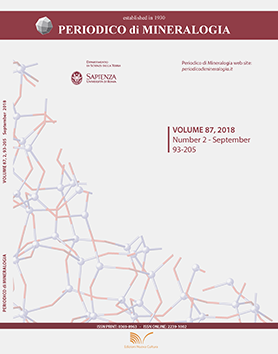Surface reactivity of amphibole asbestos: A comparison between two tremolite samples with different surface area
DOI:
https://doi.org/10.2451/2018PM791Keywords:
asbestos, tremolite, dissolution, surface reactivity, radical generation, nanoparticles, Electron Paramagnetic Resonance (EPR) Spectroscopy, High-Resolution Transmission Electron Microscopy (HR-TEM)Abstract
The present study investigates how the specific surface area modulates chemical reactivity of amphibole asbestos. Surface reactivity of a fibrous tremolite sample from Castelluccio Superiore (Italy) was investigated by means of free radical generation following incubation in an oxidant environment and compared with that of another fibrous tremolite sample (from Maryland, USA), with much smaller surface area, previously studied by Andreozzi et al. (2017). Both samples were comparable in terms of bulk, crystal and surface chemistry and only differed for their surface area, namely 10.1 and 2.75 m2g-1 for Castelluccio and Maryland sample, respectively.
Tremolite was incubated in H2O2 solution buffered at pH 7.4 for several time points, ranging from 1 day to 1 month. Structural, morphological, and chemical alterations induced on tremolite by incubation were investigated by HR-TEM and EDS. The generation of HO• and COO-• radicals following reaction of tremolite with H2O2 or formate ion was investigated by spin trapping/EPR spectroscopy.
The dissolution process and surface modification were slower for the Maryland sample, with lowest surface area. Kinetics of fibre dissolution and surface modification indicated the occurrence of either low-coordinated or high-coordinated Fe centres on the surface, as well as the evolution of nuclearity of those Fe centres (preventing or enhancing the formation of clusters and nanoparticles). In turn, iron centres determine the reaction of fibre surface with hydrogen peroxide and formate ion and the yield of HO• and COO-• radical species. The evolution of radical reactivity over time was proved to be largely dependent on surface area, with the highest radical yield occurring for low-area tremolite incubated over long times. The experimental results obtained in this study as well as the comparison with previous studies further confirm that surface reactivity of mineral fibres and inorganic particles is not dependent on Fetot content per se, but is likely due to surface properties and occurrence of specific iron sites.


